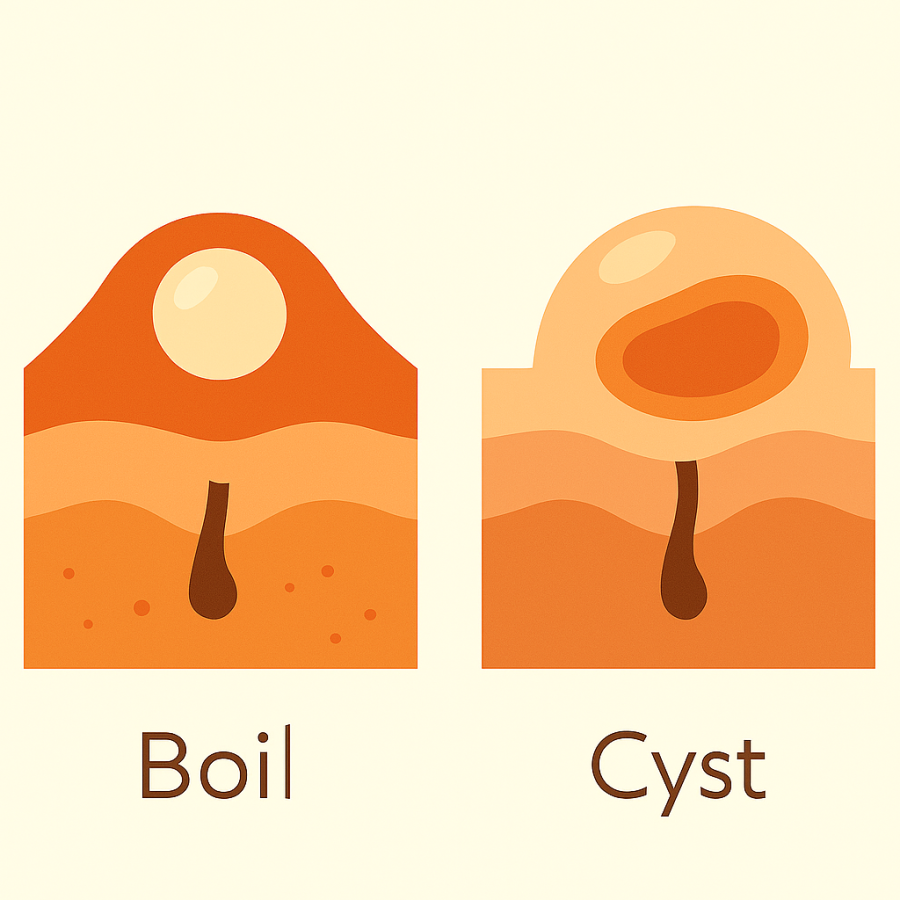Skin lumps can be confusing — is it a boil, a cyst, or something else? This easy-to-read guide explains what they are, how they differ, and how to care for them safely.
Quick answer: Boils are painful, pus-filled skin infections caused by bacteria, while cysts are usually noncancerous sacs filled with fluid, air, or other material. Both can look like lumps under the skin, but they differ in causes, symptoms, and treatments.
🩺 What are boils?
A boil (also called a furuncle) is a bacterial skin infection that starts in a hair follicle or oil gland. It often begins as a red, tender bump, becomes swollen and painful, and may develop a white or yellow “head” before draining.
- Common cause: Staphylococcus aureus (staph) bacteria.
- Appearance: Red, swollen, warm, painful lump filled with pus.
- Progression: Firm bump → softening → visible head → drainage and healing.
- Carbuncles: A cluster of connected boils causing a deeper, larger infection.
🧴 What are cysts?
A cyst is a sac-like pocket of tissue that can contain fluid, air, keratin, or oily material (sebum). Many cysts are harmless, grow slowly, and are painless unless inflamed or infected.
- Common causes: Blocked ducts, minor trauma, acne, or genetic factors.
- Types:
- Epidermoid cysts – filled with keratin, common on face/neck.
- Sebaceous cysts – filled with oily sebum, often on scalp or back.
- Pilonidal cysts – near the tailbone, sometimes infected.
- Ovarian, breast, or ganglion cysts – deeper inside the body.
-
- Appearance: Smooth, rounded lump under the skin; typically not red or hot unless infected.
⚠️ Key differences between boils & cysts
| Feature | Boil 🩸 | Cyst 💧 |
|---|---|---|
| Cause | Bacterial infection of hair follicle or oil gland | Blocked duct, trauma, acne, or genetics |
| Pain | Typically painful and tender | Usually painless unless inflamed or infected |
| Contents | Pus (infection) | Fluid, air, keratin, or sebum |
| Contagious? | Yes — bacteria can spread via contact or shared items | No — not infectious (unless secondarily infected) |
| Treatment | Warm compresses, drainage by a clinician, possible antibiotics | Monitor; drainage or removal if bothersome or infected |
🧪 Treatment options
For boils
- Warm compresses: Apply 3–4 times daily to encourage natural drainage.
- Clean & cover: Keep the area clean; use a sterile bandage to prevent spread.
- No squeezing or popping: This can push infection deeper and spread bacteria.
- Medical care: Incision and drainage (I&D) by a clinician; antibiotics for severe or recurrent cases.
For cysts
- Watchful waiting: Many cysts are harmless and can be left alone.
- Warm compresses: May help small cysts soften or drain through pores.
- Clinical options: Steroid injection for inflammation, drainage, or surgical removal to prevent recurrence.
🌱 Prevention tips
- Practice good hygiene: Wash skin regularly with mild soap; shower after exercise.
- Avoid sharing personal items: Towels, razors, and clothing can spread staph bacteria.
- Care for cuts promptly: Clean and cover wounds until fully healed.
- Reduce friction: Wear loose, breathable clothing; manage sweat in high-friction areas.
- Keep pores clear: Gentle cleansing; exfoliate once or twice weekly; use non-comedogenic products.
- Healthy lifestyle: Balanced diet, hydrate well, and manage conditions like diabetes that raise infection risk.
When to see a doctor
- Severe symptoms: Very painful lumps, rapid growth, or recurrent boils.
- Signs of infection: Fever, spreading redness, warmth, marked swelling, or multiple lesions.
- Functional impact: Cyst interferes with daily activities or becomes inflamed/infected.
✅ Quick FAQ
Are boils and cysts the same thing?
No. Boils are infections filled with pus, while cysts are non-infectious sacs that may contain fluid, air, keratin, or oily material.
Can cysts turn into boils?
Yes. If a cyst becomes infected, it can resemble a boil and may need medical treatment.
When should I seek medical help?
Seek care if the lump is very painful, keeps coming back, grows quickly, or shows signs of infection such as fever, spreading redness, or severe swelling.
Final Thoughts
Boils and cysts may look similar, but their causes and treatments differ. Boils need infection control, while cysts often just need monitoring or removal if bothersome. If you’re unsure, it’s always best to have a healthcare provider check the lump to rule out more serious conditions.

